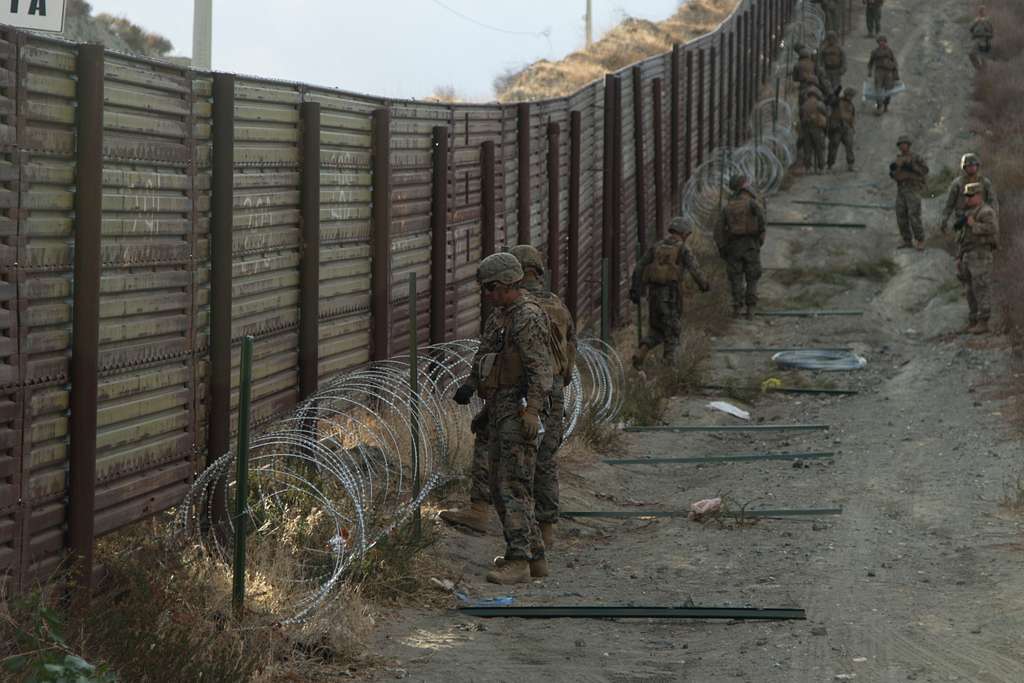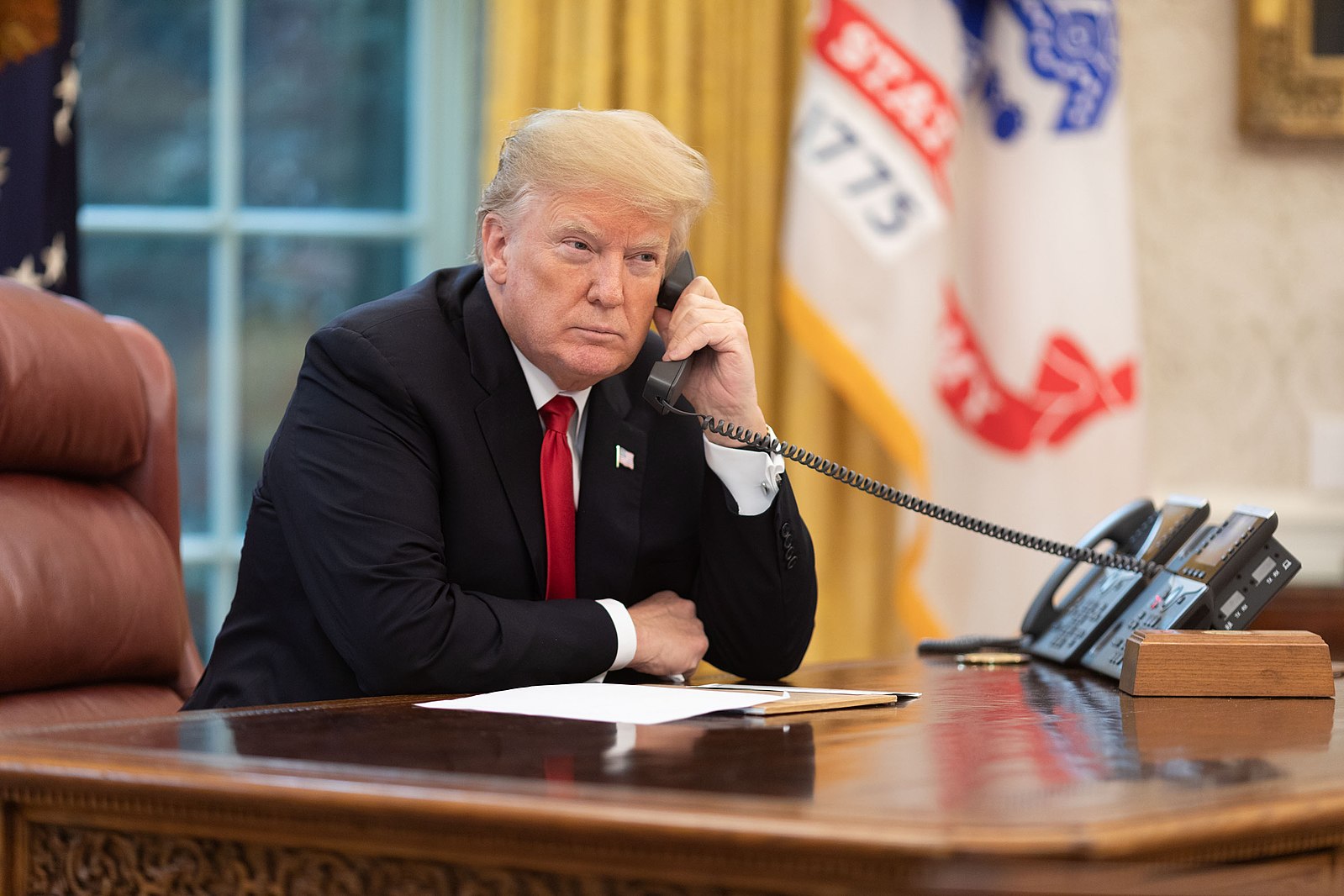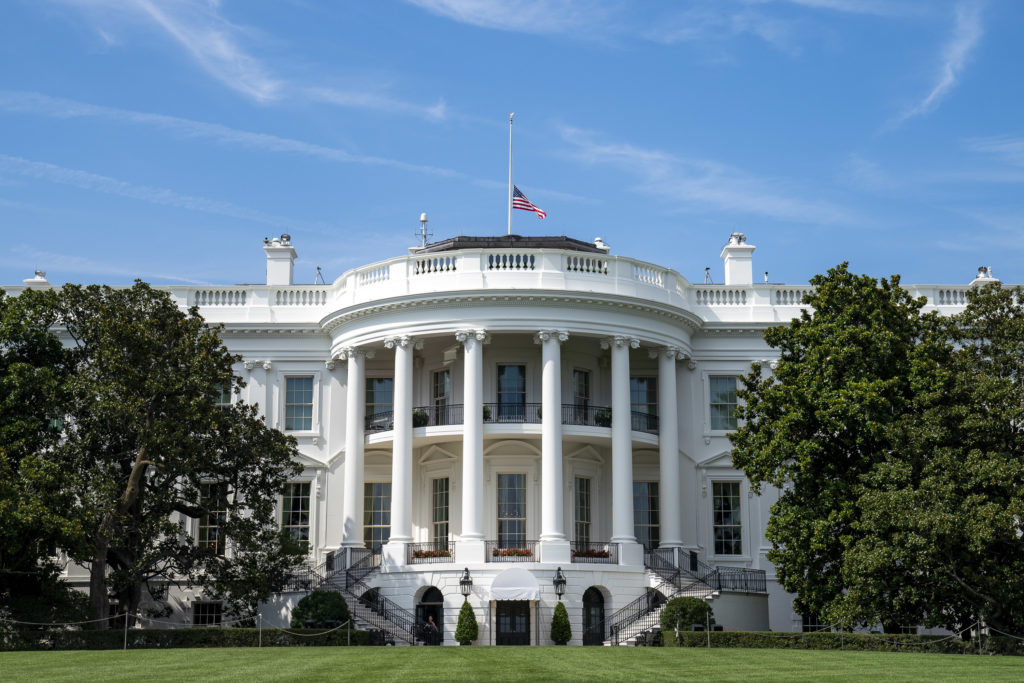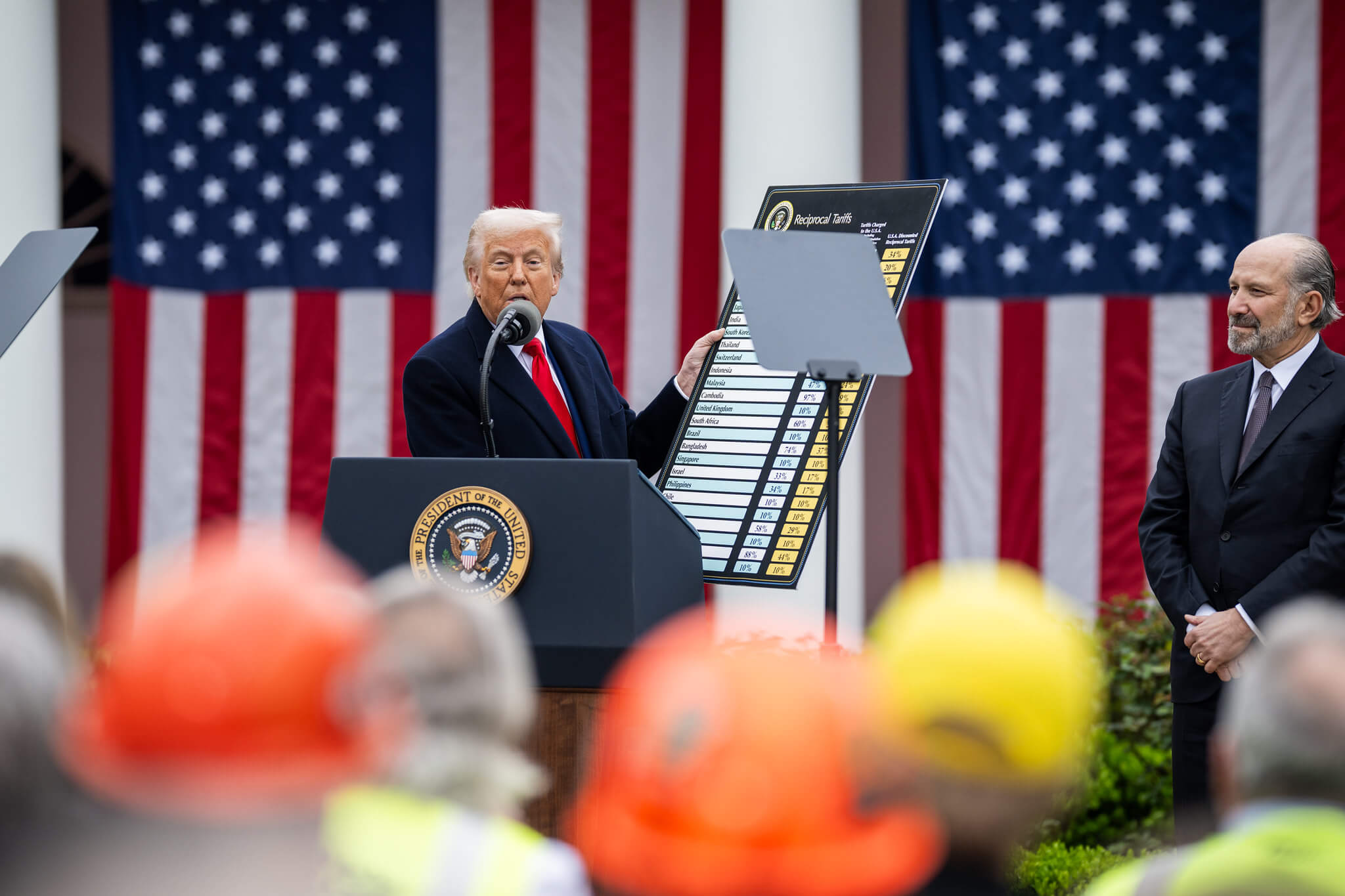Can Trump Invoke the Alien Enemies Act?
Trump wants to fit a round, troubled, 227-year-old law into the square hole of illegal immigration. What, if anything, stands in his way?

Published by The Lawfare Institute
in Cooperation With

Hours after outlining his plan to harness the Alien Enemies Act’s (AEA’s) tremendous bequest of executive authority to operationalize his mass deportation plans, President Trump delivered on his long-awaited campaign promise to do just that. In Section 3 of his executive order designating cartels, gangs, and other organizations as terrorists, Trump called upon the attorney general and secretary of homeland security to “take all appropriate action, in consultation with the Secretary of State,” to prepare to implement “any decision [he] make[s] to invoke the [AEA].” Trump hasn’t invoked the AEA—yet. However, if his latest immigration stunt—shipping deportees to Guantanamo—is any indication of his commitment to take extreme measures to fulfill broader related campaign promises, the AEA’s resurrection appears to be coming rapidly up on the horizon.
Originally passed in 1798 on the brink of war with France, the AEA was one of the four Alien and Sedition Acts—yes, those Alien and Sedition Acts—enacted in response to the XYZ Affair, which readers may recall from high school history class. The AEA is the only one of those acts that remains “good law.” In short, the law empowers the president to detain, relocate, and deport citizens of hostile nations or governments, with certain limitations. Although the AEA’s qualifications may be scant, the Trump administration may still be hard pressed to meet its parameters given the ill-fitting purpose for which he intends to employ it. However, legal challenges to Trump’s foreshadowed implementation of the law would face significant hurdles, making it difficult to predict whether those codified parameters will ultimately matter.
An Act Concerning Alien Enemies
A Federalist-controlled Congress passed the original version of the AEA in July 1798. The act was codified nearly completely intact as 50 U.S.C. §§ 21-24 after World War I. The operative language for the purposes of this article is found in 50 U.S.C. § 21, concerning the president’s powers under the act, and 50 U.S.C. § 23, regarding the role afforded to the judiciary. Per § 21:
Whenever there is a declared war between the United States and any foreign nation or government, or any invasion or predatory incursion is perpetrated, attempted, or threatened against the territory of the United States by any foreign nation or government, and the President makes public proclamation of the event, all natives, citizens, denizens, or subjects of the hostile nation or government, being of the age of fourteen years and upward, who shall be within the United States and not actually naturalized, shall be liable to be apprehended, restrained, secured, and removed as alien enemies. The President is authorized in any such event, by his proclamation thereof, or other public act, to direct the conduct to be observed on the part of the United States, toward the aliens who become so liable; the manner and degree of the restraint to which they shall be subject and in what cases, and upon what security their residence shall be permitted, and to provide for the removal of those who, not being permitted to reside within the United States, refuse or neglect to depart therefrom; and to establish any other regulations which are found necessary in the premises and for the public safety.
Section § 21 has several moving parts. First, it names the three possible options for satisfying the situational prerequisites for unlocking the president’s powers under the AEA: (a) a declared war between the United States and any other nation or government; (b) an “invasion”; or (c) a “predatory incursion.” For either of the latter options, the triggering threat must be “perpetrated, attempted, or threatened against U.S. territory by any foreign nation or government” (emphasis added), making clear that only action by a foreign sovereign entity satisfies this requirement. Second, § 21 requires the president to make a public proclamation of “the event”—that is, the declared war, invasion, or predatory incursion.
Third, it specifies that it is only upon such a proclamation that “natives, citizens, denizens, or subjects” of the specified hostile country or government can be subject to apprehension and removal. This formulation reflects the AEA’s main boundary once the situational prerequisite is satisfied: The law does not apply to U.S. citizens or nationals, by birth or naturalization. The idea of “citizen,” or “subject” for monarchies, is rather obvious. “Denizen” refers more broadly to resident aliens in a foreign country. Courts have interpreted the “native” label to apply based on an individual’s place of birth—regardless of whether they now lived or were “loyal” to the United States. Fourth, the act contemplates extremely expansive executive authorities once triggered, permitting the president to “direct” U.S. conduct with apparent unfettered discretion and establish additional regulations that are “found necessary” for the act “and for the public safety.”
Several members of the Fifth Congress recognized the AEA’s tremendous dilation of presidential power when debating its original enactment. Some, like Rep. Samuel Sewall (F-Mass.) welcomed it, believing that such power over enemy aliens needed to be “placed somewhere” and that it “could not be better placed than in the President.” Others, like Rep. Matthew Lyon (DR-Vt.), wanted to remove “vague” terms such as “threatened,” finding them inappropriately indefinite considering the power the act authorized. Indeed, “[w]here the liberty and happiness of thousands of people are concerned, he wished they might depend upon something more certain.” One of the most ardent opponents of the AEA’s broad delegations of executive power was Rep. Albert Gallatin (DR-Pa.), who believed that the AEA’s “want of legislation” left not only alien enemies but all U.S. citizens “to the will of the President.” Efforts to bridle some of the act’s pro-executive language, however, failed.
The original AEA did, however, contain a separate section, which survives as § 23, empowering federal courts to engage in a limited judicial review. Specifically, the section permits “a full examination and hearing” and review of whether “sufficient cause” exists to order the removal of an “alien” from the United States. Such review, however, appears circumscribed to situations where a complaint is brought against an “alien enemy resident” that is a “danger” to “public peace or safety … contrary to the tenor or intent of [the president’s] proclamation.” Thus, while the AEA does envisage a role for the judiciary, it is a relatively paltry one, especially compared to the executive authority it conceives. If anything, the AEA effectively commands courts to execute not the law itself but rather the president’s proclamation. Gallatin recognized as much during debates over the AEA, criticizing it for commanding the judiciary to be “obedient” not “to the laws” but rather “to the will of the President.” Other representatives likewise expressed reservations over this section, believing it “gave the President a very extraordinary power” by requiring “his proclamation, in all cases, [] to be considered as law.”
Prior Applications and Limited Judicial Elucidation
While the rest of the Alien and Sedition quartet—the Alien Act, the Sedition Act, and the Naturalization Act—all either expired or were replaced, the AEA survived the turn of the century. Presidents, however, have rarely invoked the law, employing it only three times since its enactment: during the War of 1812, World War I, and World War II. Challenges to the act’s invocation against British aliens in the War of 1812 produced several decisions concerning the AEA’s operation, scope, and validity. In Lockington v. Smith, Justice Bushrod Washington, riding circuit, held that no judicial action, including a court order, was required before an alien enemy could be detained. Rather, judicial review needed to be available only after incarceration. According to Washington, Congress, in enacting the AEA, “intended to make the judiciary auxiliary to the executive.” The Supreme Court also appeared to confirm the act’s delegation of broad executive authority in Brown v. United States, finding that it “confer[red] on the President very great discretionary powers respecting th[e] persons” of alien enemies that did not otherwise exist. Nevertheless, in United States v. Thomas Williams, Chief Justice John Marshall, on circuit in Virginia, confirmed that “habeas corpus lies to determine the boundaries of” the AEA’s authorizations to the executive, ordering the release of a British citizen who had been taken into custody by U.S. marshals in accordance with presidential order (technically made by the State Department) because he had not been “assigned” a place to “be removed to.”
The United States and Great Britain concluded the Treaty of Ghent in December 1814, and the AEA retreated from the annals of history only to come out of the woodwork during World War I. In 1917, after Congress had declared war against Germany, Woodrow Wilson issued a proclamation triggering the act, citing “a state of war existing between the United States and [Germany]” and identifying “all natives, citizens, denizens, or subjects of Germany … within the United States and not actually naturalized” as “alien enemies.” Stephen Vladeck has previously offered a detailed review of some of more significant World War I-era decisions interpreting the AEA. Suffice it to say here that these decisions suggest that at least some conduct under the act is reviewable by courts; specifically, whether a detainee has the necessary foreign “status” (which has thus far been interpreted to mean citizenship but could, in theory and per the statute’s text, be expanded) to qualify as an “alien enemy” under the act so as to be subject to a presidential proclamation made pursuant to it.
World War II saw nine proclamations made under § 21 either triggering the AEA, as Proc. No. 2525 did against “all natives, citizens, denizens or subjects of the Empire of Japan,” or amending a previous proclamation, as with Proc. No. 2533. (Incredibly, Truman also used this authority to deport not only foreign citizens who had come to the United States of their own accord but also those who had actually been abducted from Central American countries and interned in the United States.) Proclamations ordering the removal of alien enemies under the act were issued as late as December 1945, long after both V-J Day and V-E Day. It is worth pausing here to clarify that internments of foreign Japanese, German, and Italian nationals made pursuant to § 21 proclamations were separate from the internment of Japanese Americans.
During World War II, lower courts heard several AEA cases but largely confined their review to the statute’s application—and, more specifically, to whether a detainee satisfied its “status” requirements. The period also produced the first Supreme Court decision to directly consider the law. In 1948, the Court took up a challenge to the AEA instituted as a habeas petition by Kurt Ludecke, a German national who was ordered to be removed from the United States in 1946, after fighting had ceased. Rejecting his challenge, the 5-4 majority in Ludecke v. Watkins unequivocally affirmed the AEA’s exceptionally pro-executive posture. Specifically, the Court doubled down on a strong doctrine of deference to the president’s determination to restrain and remove “enemy aliens” and establish other regulations “necessary … for the public safety” under the then-existing circumstances. In the words of Justice Felix Frankfurter, who penned the majority opinion, “[t]he very nature of the President’s power to order the removal of all enemy aliens rejects the notion that courts may pass judgment upon the exercise of his discretion.” Citing Justice Washington’s logic in Lockington, the majority robustly declined the invitation to place limits on the president’s authority to remove enemy aliens that Congress itself “ha[d] not seen fit to impose.”
Nevertheless, the Court did carve out some role for the judiciary: Although the AEA generally “preclude[s] judicial review,” courts could still hear habeas corpus petitions “challeng[ing] the construction and validity of the statute, ... the existence of the ‘declared war,’” and the status of the detainee as “an alien enemy fourteen years of age or older.” Thus, the judiciary is not idle in reviewing actions taken pursuant to the AEA: Rather, judges can and should scope whether the act’s prerequisites have been met and whether an individual is indeed an “enemy” under the relevant statutory definition.
Invoking the statute’s age as an asset to its validity, the Court further rebuffed Ludecke’s due-process challenge: Its contemporaneity with the Constitution itself dictated judicial caution, as “it would savor of doctrinaire audacity now to find the statute offensive to some emanation of the Bill of Rights.” As for the question of whether a state of war still existed in 1946, the Court left the determination to Congress and the president, believing it to be a nonjusticiable political question.
In a blistering dissent, Justice Hugo Black summarized the effect of the decision as allowing “any unnaturalized person, good or bad, loyal or disloyal to this country, if he was a citizen
of [a hostile nation] before coming here, ... [to] be summarily seized, interned and deported from the United States by the Attorney General, and that no [U.S.] court … has any power whatever to review, modify, vacate, reverse, or in any manner affect the … order.” Frankfurter, however, was aware of the tremendous executive power his opinion recognized: Conceding that there was “no doubt” that “[s]uch great war powers may be abused,” he believed “that [wa]s a bad reason for having judges supervise their exercise,” regardless of whatever limitations judges self-imposed for such supervision.
Trump’s Trump Card
As Trump’s executive order suggests, his contemplated invocation of the AEA appears to target cartels and gangs. Indeed, his other order “guaranteeing the states protection against invasion,” which takes direct aim at illegal immigration more broadly, doesn’t reference the AEA. Nevertheless, considering the scope of executive power the AEA unlocks, the law, even if meant to target cartels—er, “terrorists”—could be used as an unchecked and highly flammable accelerant for deportations of immigrants writ-large based on mere suspicions of cartel association. Formally triggering the act, however, still requires a finding that one of three aforementioned prerequisite conditions exists.
Trump’s order appears to specifically contemplate an AEA invocation based on a “qualifying invasion or predatory incursion”; however, his decision to designate cartels and other organizations as terrorists might be leveraged by his administration to support a “declared war” argument. The act does not specify whether the United States must be the one to declare war, and it is (hopefully) uncontroversial to say that no country—or cartel—has declared war on the United States. Thus, to trigger the AEA using the “declared war” option, Trump would need to argue that Congress, with whom the power to declare war exclusively sits, has declared war against a foreign nation or government. This raises two issues: Has there been a declaration of war and, if so, against what nation or government? Again, it would appear uncontroversial to say that Congress has not “declared war” since 1942. Even if Congress were to do so, it’s not clear what “foreign nation or government” would be the supposed targeted belligerent. Trump’s previously stated intention to use the AEA to “remove all known or suspected gang members, drug dealers, or cartel members from the United States” and return them to their unspecified countries of origin would require identifying the “alien enemies” to be removed not by their status as citizens of a belligerent nation or government, as required by the act, but by their membership in a non-state group. Moreover, his unsubstantiated—and definitely contested—allegations of the cartels’ “alliance” with Mexico does nothing to patch this flaw.
However, Trump’s prior rhetoric, describing U.S. cities as “war zone[s]” that have been “invaded and conquered” by gangs, as well as that of his secretary of homeland security, suggests he is eyeing the AEA’s “invasion or predatory incursion” language.
At least insofar as unauthorized immigration—of cartels or otherwise—is the true motivation behind an invocation, the “invasion” option might be a hard sell. First, the AEA’s history suggests that “invasion” was meant to refer to a certain level of hostility or relate to war. The Fifth Congress’s debates over the AEA reflect that a key motivation for its passage was the fear of foreign invasion stemming from the undeclared war with France. James Madison, who was president when the AEA was first invoked during the War of 1812, described invasion as “an operation of war” in an 1800 analysis of the act. Furthermore, the only time the act was invoked on the basis of an “invasion” was after Pearl Harbor on Dec. 7, 1941. Specifically, President Roosevelt triggered the AEA upon proclaiming “that an invasion has been perpetrated upon the territory of the United States by the Empire of Japan,” although Congress did not declare war on Japan until the following day.
Second, while no court has expressly interpreted “invasion” in the context of the AEA, the definition of “invasion” in the constitutional sense has received recent judicial and scholarly attention. Early last year, Texas tried to make the immigration-as-invasion argument in two cases, United States v. Texas and United States v. Abbott, the former of which dealt most directly with the claim. There, a district court—after providing one of the most comprehensive analyses of “invasion” in the State War Clause—enjoined the enforcement of Texas law that established state criminal liability for immigration law violations. Although the U.S. Court of Appeals for the Fifth Circuit ultimately stayed the injunction, it was “not persuaded” by Texas’s immigration-as-invasion argument. The case is still pending. In light of interpretative uncertainty, recourse might also be had to interpretations of the president’s unilateral authority to use force to repel attacks or invasions.
Interpretative aids for “predatory incursion” are even sparser. Founding-era history suggests that the term referred to violent attacks or raids, including during the Revolutionary War. Furthermore, at least one member of the AEA’s enacting Congress withdrew his concern that the language granted “very extensive” power to the president that should only “be given … in case of serious attack” because he had misunderstood the provision.
This uncertainty aside, both the “invasion” and “predatory incursion” options suffer from the same fatal defect as the first option: They are triggered only upon the kinetic action of a foreign nation or government. Thus, unless Trump is contemplating recognizing gangs as governments, both these options appear likewise precluded—rhetoric notwithstanding.
With a unified government and ever-salient “separation of parties, not powers,” one other option for invocation may be amendment, though this is unlikely to resolve some of the thornier legal issues complicating Trump’s plans. The Republican Party endorsed the idea of using the AEA to “remove all known or suspected gang members, drug dealers, or cartel members from the United States” in its official 2024 party platform. Thus, rather than checking the president, the Republican-controlled Congress could try to push through amendments expanding the AEA’s application to illegal immigration. This wouldn’t be the first time Congress contemplated such revision. In 1980, a year after the Iranian hostage crisis, Rep. G. William Whitehurst (R-Va.) introduced a bill that would amend the AEA to add two additional paths for invocation: the seizure of a diplomatic mission or of such premises along with the taking of diplomatic hostages. In a letter to Sen. Edward Kennedy (D-Mass.), however, according to the Brennan Center, the Justice Department’s Office of Legal Counsel (OLC) questioned the bill’s constitutionality and suggested that the AEA’s detention and deportation powers were cognizable only during times of war. (OLC revisited the AEA in 2001 in an opinion on using military commissions to try terrorists, suggesting that the scale of executive competency the act sanctioned was justified because of the need to ensure “war-time security.”)
Seizing upon footnote language in Ludecke, the Trump administration may also try to point to congressional appropriations for its mass deportations plans to support its cause. In footnote 19, the majority suggests that Congress “anticipated the decision” and “confirm[ed] and ratif[ied]” the president’s actions by appropriating funds for expenses necessary for detaining and transporting enemy aliens and their families. Such appropriations, however, are not only unlikely to manifest any time soon but would also likely have to be similarly specific and tailored to constitute sufficient evidence of ratification.
Challenges for Challenges
As the above analysis demonstrates, Trump’s invocation of the AEA is anything but straightforward—and groups like the ACLU and Brennan Center have been gearing up to operationalize many of the aforementioned obstacles into legal opposition since Trump made his intentions for the law clear on the campaign trail. Other previewed arguments include due-process, equal-protection, and separation-of-powers challenges. Even adopting the logic that the United States is experiencing either a war or an invasion or incursion, there may be paths to constrain and challenge executive discretion and action by invoking the country’s obligations under the Fourth Geneva Convention of 1949. Furthermore, the aforementioned role of the courts staked out in Ludecke must not be discounted. Thus, perhaps there is hope yet that a potential invocation of the AEA will be halted, if not by the administration’s own conscience then by the courts. Indeed, in the words of Saint Augustine, who fittingly compared unjust governments to gangs, “[i]n the absence of justice, what is sovereignty but organized robbery?”
Nevertheless, prospective opponents may face two sizable legal roadblocks: foreign relations exceptionalism and the political question doctrine. Courts have repeatedly granted heightened deference to the executive in the context of foreign affairs, and have exercised greater judicial tolerance for extremely broad delegations of power over foreign policy, military, and national security matters. Moreover, even after the Supreme Court truncated the Baker factors in Zivotofsky, somecourts have remained wary of wading into the political thicket where matters of foreign policy and national security are concerned. Thus, it is quite conceivable that courts will defer to the executive’s determination, for example, that an invasion or predatory incursion exists for the AEA’s purposes, or deem such ascertainment a nonjusticiable political question. Indeed, after deeming the determination of when a war ends a political question, Justice Frankfurter concluded his Ludecke opinion stating that the president, whom the founders:
entrusted with such vast powers in relation to the outside world was also entrusted by Congress, almost throughout the whole life of the nation, with the disposition of alien enemies during a state of war. Such a page of history is Worth more than a volume of rhetoric.
As daunting as these judicial barriers may seem, congressional action to repeal or temper the AEA is likely dead-on-arrival given partisan gridlock, calling to mind Justice Robert Jackson’s presage in Youngstown that the “rise of the party system has made a significant extraconstitutional supplement to real executive power.” American and foreign citizens alike will therefore likely have to wait and watch as the inevitable legal challenges to a possible AEA invocation make their way through the courts to see whether the judiciary takes it upon itself to prevent the unforeseen—and, perhaps, unintended—aggrandizement of executive power. Perhaps, however, the new administration will be persuaded by the reasoning above and other arguments that any attempt to resuscitate the AEA in this context will not only be exceptionally ill conceived but also blotch a new stain on the act’s—and the country’s—already marred history.
Author’s Note: Although the few cases and OLC opinions that discuss it refer to it as the Alien Enemy Act (see, e.g., Ludecke v. Watkins, 335 U.S. 160, 162 (1948)), President Trump, as well as most modern coverage, commentary, and analysis, refers to the statute as the Alien Enemies Act. As such, the article adopts this contemporary nomenclature.





